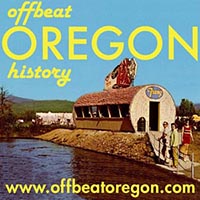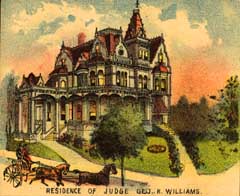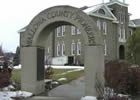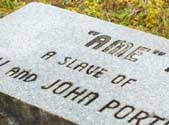C.C. Beekman, Jacksonville banker
The former miner and Wells Fargo stagecoach agent outfoxed would-be stagecoach robbers by shipping gold in candle boxes.

Table Rock, in Southern Oregon -- the promontory after which
Jacksonville was originally named. (Postcard image, circa 1905)
By Manly Banister — July 11, 1939
This is an interview by WPA Writers Project writer Manley M. Banister with Portland attorney Benjamin B. Beekman, done on July 11, 1939, at Banister’s office, in the Platt Building at 2071 S.W. Park Avenue. Mr. Beekman lived in the historic Portland Hotel at the time.
———
Mr. Banister had this to say about his subject:
Benjamin Beekman is the son of C. C. Beekman, Wells-Fargo agent and banker of early historic days of Jacksonville, Oregon. Left the community when he was seventeen to go to school; studied law at Yale, and returned from thence to Portland. He has lived in the same room in the Portland Hotel, using the same key, for the past 40 years.
He is a tall, spare man with grayed hair and mustache. Wears pince-nez glasses. He is seventy-six years old. Offers annual prizes through Oregon Historical Society to students between ages of fifteen and eighteen on subjects of Oregon history. He thinks the younger generation ought to know more than it does about Oregon history.
———
Following is Mr. Beekman’s story, as told to writer Banister:
My father, C. C. Beekman, came west in 1850, landing in San Francisco. His father had been a contractor and he had taught his boys the trade. He found plenty of work in San Francisco and went to work at once. He came to Jacksonville in 1852, mining for a while nearby. He made quite a bit of money and sold out and commenced buying gold, which was the start of his banking business.
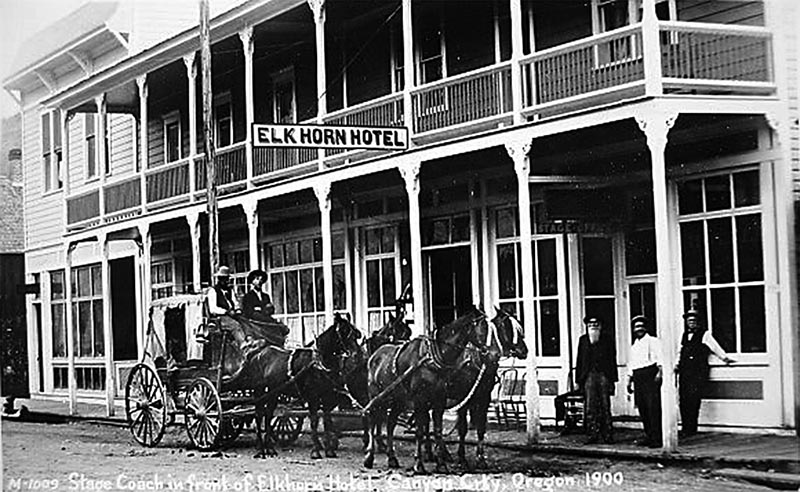
A vintage postcard image showing the stagecoach in
a frontier Oregon
mining town
— in this case, Canyon City.
Later, when the Wells-Fargo express-company put in its appearance, he was appointed agent. The stage stopped at his door where all goods and passengers had to be loaded, so he worked under an advantage so far as robbers were concerned. No one knew when he was going to make a shipment of gold.
Another thing to his advantage was that he never shipped gold in the iron-bound express box. When bandits hold up the stage, it was customary for them to ask for the registered mail and the express box. My father would take an ordinary candle box, put in fifteen hundred or three thousand dollars' worth of gold, and fill up the remaining space with paper, straw, or excelsior, so that the weight of the loaded box was about equal to what it would be if it were loaded with candles. This he would ship, confident in the knowledge that no highwayman would rummage around among the baggage, looking for gold in an old tallow box.

A postcard image of the old county courthouse in Jacksonville.
This building was a later addition to the town.
The only time there was any danger of a hold-up was along in 1910 when the Pinkerton agency, under whose protection he had placed his bank, unearthed a plot in Portland to rob the bank. Officers stayed around across the street for several days with pistols and rifles, waiting for the would-be hold-ups to arrive, but they must have got wind the bank was being watched, for none of them ever came.
If you go into a newspaper office or pick up the usual history book, you will find that the usual reason for the railroad's passing through Medford instead of through Jacksonville is that the citizens of Jacksonville failed to gather in a bonus required by the railroad; but this is not true at all.
The railroad made two surveys, one passing through the present site of Medford (which was not in existence then), and another that passed within two and a half miles of Jacksonville. Medford is five miles distant. The present route is the longer, while the other ran along the base of the foothills, it all depended on Ashland. If the closer survey more adhered to, the line would wind up into the hills above Ashland; otherwise, on the flats below.
It so happened that Ashland was placed in a strategic position to be a division point of the railroad, and this determined the survey as the one in present use. The other would not have permitted the building of roundhouses, workshops, and necessary appurtenances of a railroad division.
Considering these things the citizens of Jacksonville saw it was useless to raise the money required, for the difference in a distance of two-and-a-half miles from town to the railroad, and the present distance of five miles was not enough to get fractious about. Either would have spelled doom to the town of Jacksonville, either by creating a new town (viz. Medford), or by moving the business district of the old, two-and-a-half miles to the railroad. This is the real reason why the railroad now runs through Medford instead of through Jacksonville.
(Original story at https://lcweb2.loc.gov/cgi-bin/query/S?ammem/ wpa:@field%28DOCID%28@range%28wpa229010107+ wpa330020403%29%29%29 )

